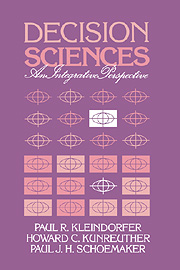5 - Evaluating prescriptive approaches
Published online by Cambridge University Press: 05 June 2012
Summary
Introduction
The previous three chapters have described how problems are identified and evaluated. We have discussed several different types of theories concerned with how decision makers perform these activities:
Descriptive theories: These are theories and associated experimental evidence and field studies concerned with how actual decision makers actually perform these activities.
Normative theories: These are theories like expected utility theory based on abstract models and axioms that serve as theoretical benchmarks for how decision makers should ideally perform these activities.
Prescriptive theories: These are theories and associated experimental evidence and field studies concerned with helping decision makers improve their performance in problem finding and problem solving, given the complexities and constraints of real life.
The dominant features of the descriptive theory we have presented are the limitations in cognitive abilities of decision makers, leading to systematic biases in choice behavior when compared with normative benchmarks such as expected utility theory and statistically based inference and prediction procedures. We have also indicated some prescriptive approaches, such as bootstrapping, to improve (although not necessarily optimize) decision making.
In discussing these descriptive, normative, and prescriptive theories, we have considered problem finding and problem solving as an ordered, interconnected set of phases: identification, representation, acceptance, alternative generation, evaluation, and choice. We now consider several holistic approaches to problem solving, with a view to providing a synthesis of the descriptive, normative, and prescriptive theories previously discussed. These holistic approaches may be viewed as competing prescriptive theories for accomplishing and piecing together the problem-solving phases mentioned previously.
- Type
- Chapter
- Information
- Decision SciencesAn Integrative Perspective, pp. 177 - 210Publisher: Cambridge University PressPrint publication year: 1993

